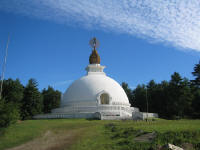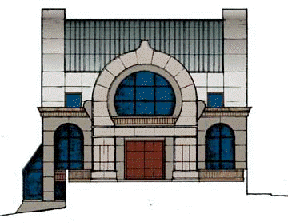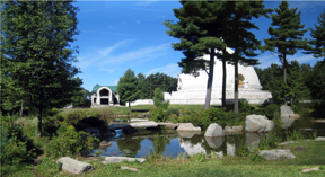| Nipponzan Myohoji | ||
| New England Peace Pagoda | ||
 |
||
|
Heaven on earth |
||
| Architectural Record, August 1986 | ||
|
The most Venerable Nichidatsu Fujii built his first pagoda on a mountain in Japan after the bombing of Hiroshima and Nagasaki. A Buddhist monk and founder of the Nipponzan Myohoji order, Fujii consecrated the domed shrine to universal peace and enlightenment, reviving both the form and religious purpose of a 2,500-year old tradition of stupa design that originated in India. "The appearing of a pagoda touches the hearts and minds of all people," he explained. "Those who venerate this pagoda absolutely reject nuclear warfare and firmly believe that a peaceful world will be manifested." Before his death in January 1985, at the age of 100, Fujii had inspired the construction of more than 70 pagodas in Asia and Europe, and overseen the beginnings of the first in North America, the Leverett Peace Pagoda. The site for the latest project, a wooded hilltop in western Massachusetts, was donated to the order, as were the services of the professionals who designed the stupa and the labor of the nearly 1,000 volunteers from many faiths who built it over one and a half years Louis Mackall, the architect, knew little about Buddhism until he met nuns and monks from Nipponzan Myohoji as fellow demonstrators protesting the Trident submarine. Reciprocal good will (and a joint leap of faith) led to the peace pagoda commission, a collaborative effort with engineer J. Robert Jennings, Rev. Mamoru Kato, head monk at the small monastery that tends the shrine, and a host of others. As a Westerner from a professedly "secular background," whose career had focused hitherto on private residences and custom furniture, Mackall approached the creation of a stupa somewhat uneasily. Fujii and Kato had already agreed on a generic model, the second-mnturyB. C. tope at Sanchi, India, one of the earliest pagodas erected to house Buddhist relics. But beyond determining the basic type of a domical structure with central pinnacle, and a thematic program for sculptural iconography, they hoped their architect would reinterpret precedent according to his own lights, as an American. To that end, Mackall intensively drew and redrew the elementary contours and decorative motifs he was shown in photographs of Sanchi and modern peace pagodas, striving for a sense of intimacy with alien shapes and symbols, and a measure of the plastic vigor he saw in the ancient prototype but found lacking in many contemporary stupas. Once this research had been sufficiently "edited" by Buddhist advisors and pondered with Jennings to produce a schematic outline of the concrete pagoda's form and structure, Mackall began modeling clay maquettes of sculptural details, such as a lotus-blossom frieze and ogee-arched niches. These three-dimensional sketches were then transposed into three-quarter-scale plaster casts. The filigree "water-flame" finial of the pinnacle, largely conceived by artist Shin Higuchi, was laser-cut from aluminum, a rare intrusion of sophisticated technology. In general, construction relied on sweat, ingenuity, and solidarity: "All of the pure energy brought to the process of building the pagoda remains here," says Kato. Trees cleared on site were lashed together for scaffolding, and formwork and trusses for the 80-footdiameter dome and its podium were assembled by hand from scrap wood. While volunteer Earl Johnson pneumatically sprayed the shell over rebars, a team of Sri Lankans troweled its curved surface (their adjustments by eye were accurate to within an eighth of an inch of Jennings's screed). The same team sculpted freehand concrete statues. Mary non-Buddhists who helped out for a few days or even weeks during construction were perplexed by the lack of any apparent access to the interior of the dome, which in the finished stupa is permanently sealed. Visitors still wonder why there is no "inside," no clear destination, as they watch saffron-robed monks and nuns circumambulate the outdoor walkways beating hand drams and chanting. There are many possible replies to the lingering question. Rev. Clare Carter, a nun at the pagoda, suggests one of them: "Our teacher was always trying to make the point that heaven is also this world. Our life here is a creation of this heaven through human effort." Architectural Record August 1986
|
||
|
Temple under construction |
 |
 |
| BACK TO HOME PAGE | ||